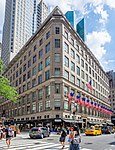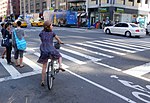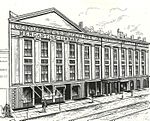The Villard Houses are a set of former residences comprising a historic landmark at 451–457 Madison Avenue between 50th and 51st Streets in the Midtown Manhattan neighborhood of New York City. Designed by the architect Joseph Morrill Wells of McKim, Mead & White in the Renaissance Revival style, the residences were erected in 1884 for railroad magnate Henry Villard. They comprise a portion of the Lotte New York Palace Hotel, the main tower of which is to the east.
The building comprises six separate residences in a "U"-shaped plan, with wings to the north, east, and south surrounding a courtyard on Madison Avenue. The facade is made of Belleville sandstone, and each house consists of a raised basement, three stories, and an attic. Among the artists who worked on the interiors were artist John La Farge, sculptor Augustus Saint-Gaudens, and painter Maitland Armstrong. Some of the more elaborate spaces, such as the Gold Room, dining room, and reception area in the south wing of the complex, still exist as part of the New York Palace Hotel.
The houses were commissioned by Henry Villard, president of the Northern Pacific Railway, shortly before he fell into bankruptcy. Ownership of the residences changed many times through the mid-20th century. By the late 1940s, the Roman Catholic Archdiocese of New York had acquired all of the houses, except the northernmost residence at 457 Madison Avenue, which it acquired from Random House in 1971. The New York City Landmarks Preservation Commission designated the complex an official landmark in 1968, and the residences were listed on the National Register of Historic Places in 1975. As part of the construction of the New York Palace Hotel, completed in 1980, the north wing was turned into office space for city preservation group Municipal Art Society.










